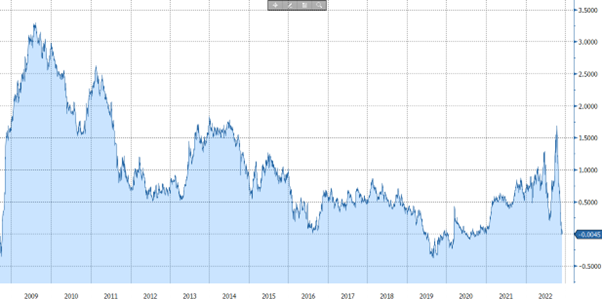
Diverging Central Banks, Diverging Inflation
25 November 2022
Canada and the US – diverging policies, diverging economies
2 December 2022INSIGHT • 30 NOVEMBER 2022
Bankers versus the economy: Rates hedging in 2023

Shane O'Neill, Head of Interest Rate Trading
The rates market, which has been particularly volatile these last few weeks, appears to be at an inflection point. Whilst rates have been a one-way bet for much of the past year, the next period may see two-way volatility: economic data and central bank rhetoric is increasingly at odds, creating opportunities and risks for hedgers. In today’s Big Picture, we look at the US and UK markets and ask: What really matters for risk managers and how can they best position themselves for the months ahead?
The US: The Fed versus the market
The Federal Reserve has been consistent and resolute in its messaging: rates are increasing. During the most recent Fed meeting, Chairman Powell provided three key takeaways: 1) the market is underestimating how high rates need to go, 2) rates may stay elevated for longer than expected, and 3) under-hiking is a bigger risk than over-hiking. Other Fed members have backed this hawkish message. The Fed’s Bullard, for example, reiterated that there are more hikes to come, with rates at 5-5.25% the least we could expect.
Interestingly, the market appears to be “ignoring” the Fed’s comments, with terminal rates peaking at just under 5% - the bottom of Bullard’s range. Indeed, in the weeks following Powell’s hawkish rhetoric, we saw expected terminal rates tumble almost 30bps. These moves, however, are not without reason. US inflation has undershot expectations at 7.7%—the fourth consecutive month of falling inflation—providing the market with added confidence that the peak is behind us. On top of this, there have been recent indications that the economy is slowing: PMI data missed market expectations and the Fed minutes showed a 50/50 bet for a recession.
This creates a unique setting for risk managers. People often view central bank rhetoric as guiding future rates moves. If this is true, there is a good argument for those exposed to floating rates to take advantage of the recent market moves. But rhetoric is just rhetoric and nothing is guaranteed. If the economy continues to slow, we could easily see the Fed pivot. After all, this is the same Fed who, in very recent memory, was convinced inflation was transitory. A set up like this lends itself to hedging with caps in order to protect the upside whilst allowing participation to the downside, and in the last month we have seen the premium required to purchase a 5-year 5% cap fall some 30% from its peak.
The UK: The BoE, inflation, and a downward sloping curve
The situation in the UK is almost the complete opposite of that in the US. Whilst Governor Bailey also addressed market pricing directly in the most recent Bank of England (BoE) meeting, he claimed that the markets had pushed rate expectations too far, leaving the market to infer the BoE would be hesitant to take rates above 5%. Bailey went on to paint a difficult picture for the UK over the coming years, predicting a recession that will last longer than any since the 1920s and wipe a total of 3% off the UK economy. This is a difficult environment to hike aggressively into.
Again, the market is making life challenging. Recent CPI figures came out higher than expected at 11.1%, providing no sign of a peak for the UK. Mixed messaging from the BoE is also complicating matters for would-be rates hedgers. Both Huw Pill and Dave Ramsden have recently suggested rates will continue to increase. Whilst this is not necessarily at odds with Bailey, it is certainly a different tone. Thus far the market is paying more heed to Bailey than inflation, with short-end rates expected to peak around 4.5%. Moreover, the market believes rates will need to fall quite quickly after hiking to help the economy out of recession, resulting in a downward sloping swaps curve.
A downward sloping swaps curve creates an opportunity for hedgers to fix their exposure without increasing interest costs in the short term (e.g., the rate on a 7y SONIA swap is now the same as 3-month SONIA). This set up is novel for hedgers who tried to fix their debt between 2008 and 2020. The curve during this period was upward sloping and fixing your exposure meant increasing your interest costs significantly in the short term. Hedgers looking to take advantage of this may wish to move quickly. A huge increase in gilt supply in the coming years from BoE balance sheet unwinds and increased issuance related to government borrowing may cause longer end yields to move materially higher.
Chart 1: Medium to long term swaps rates are now close to, or lower, than short term rates

Source: Bloomberg
Whilst the push and pull between central bankers and economic data pricing remains key, central bank speak is critical to understanding how the future may unfold. With volatility likely to remain a central feature, considered rates hedging is perhaps at more crucial now than any point in the last 12 months.
Be the first to know
Subscribe to our newsletter to receive exclusive Validus Insights and industry updates.



